(解説)ニューヨークの国連本部で8日から3日間の日程で始まったエイズ終結に関する国連総会ハイレベル会合は、初日に政治宣言が採択されました。さっさと終わらしてしまおうということでしょうか。エイズ終結の言葉は勇ましいけれど、実は国際社会の「エイズはもういいだろう感覚」が露骨に反映され展開のような印象がしないこともありません。あくまで、極東の島国からNYを遠望した範囲での個人的な印象ですが・・・。
とりあえず、UNAIDSのサイトに載っていたプレスリリースの日本語仮訳です。後半は行事の宣伝で、あほらしくなって訳がおざなりになっているかもしれません。
それでも中盤にはこんなくだりもありました。
『しかし、成人の新規HIV感染は2010年以来、ほとんど減少していない。そして、若い女性・女児および、セックスワーカー、受刑者、ゲイ男性その他の男性とセックスをする男性、トランスジェンダーの人たち、注射薬物使用者ら特定の集団の人たちを含め、あまりにも多くの人が対策から置き去りにされたままだ』
あくまでプレスリリースレベルですが、押さえるところは押さえ、生かせるところは生かして、日本国内でも今後の対策につなげていく必要があります。

エイズ終結に関する果敢な新政治宣言をニューヨークで採択
国連加盟国が2020年に向けた野心的ターゲットに合意。誰も置き去りにせず、2030年までに公衆衛生上の脅威としてのエイズ流行を終結させることを誓約
UNAIDSプレスリリース
【ニューヨーク国連本部 2016.6.8】エイズ流行終結に関する革新的で実行可能な新政治宣言が本日、米・ニューヨークで開かれたエイズ流行終結に関する国連総会ハイレベル会合で加盟国により採択された。持続可能な開発目標(SDGs)に基づく2030年のエイズ流行終結を目指し、宣言には2020年という締切りを明示して達成すべき一連の個別ターゲットが盛り込まれている。
政治宣言の約束を新たなものにし、世界が公衆衛生上の脅威としてのエイズの流行を2030年に終結させるための軌道を進むために、エイズ終結に関するハイレベル会合には、各国の国家元首、政府首脳、閣僚、HIV陽性者、市民社会代表、国際機関、民間企業、科学者、研究者らが集まった。
「世界のコミュニティが、持続可能な開発目標のもとでエイズの流行を終結させる決意を持って結集しました」と国連総会のモーエンス・リュッケトフト議長は語った。「この会合は、HIVに影響を受けているすべての人がより健康に生活できるようにし、将来の試練に備えより強い社会を築くための土台となるものです」
「世界は、同時代の大きな公衆衛生課題であった流行終結の機会を得ました」と国連合同エイズ計画(UNAIDS)のミシェル・シディベ事務局長は述べた。「ここでなされた決定は、新規HIV感染ゼロ・エイズ関連の死亡ゼロ・差別ゼロの約束を含め、革新的で、エビデンスに配慮し、社会正義に基づいて2030年のエイズ流行終結という課題を解決するための大きな出発点となるでしょう」
2011年のHIVとエイズに関する国連総会会合以来、HIV対策は目覚ましい成果をあげてきた。2015年12月現在、抗レトロウイルス治療を受けている人は170万人を超えている。子供の新規HIV感染件数およびエイズ関連の死亡者数は大きく減少した。HIV陽性者の結核による死亡も減っている。
しかし、成人の新規HIV感染は2010年以来、ほとんど減少していない。そして、若い女性・女児および、セックスワーカー、受刑者、ゲイ男性その他の男性とセックスをする男性、トランスジェンダーの人たち、注射薬物使用者ら特定の集団の人たちを含め、あまりにも多くの人が対策から置き去りにされたままだ。
エイズ終結に関するハイレベル会合は今後5年間のHIV対策の高速対応アプローチの重要性に焦点が当てられた。エイズ流行終結に向けたUNAIDSの高速対応アプローチには、締切りを設定した一連のターゲットが盛り込まれている。2015年に210万人[180万~240万人]だった新規HIV感染を2020年には50万人以下に減らす。2015年に110万人だったエイズ関連の疾病による死者を2020年には50万人以下に減らす、HIV関連の差別をなくすといったターゲットがその中には含まれている。
エイズ終結に関するハイレベル会合の期間中、参加者は一連の会議やイベントに加わり、科学的な成果と持続的な資金確保、スティグマや差別の解消、社会正義の確立、誰も置き去りにすることがない明るくインクルーシブな社会の実現などを通して、宣言を具体的な行動に移していくにはどうしたらいいのかを議論する。
エイズ終結を社会変革と持続可能な開発につなげるための方策、エイズ終結と新規HIV感染防止のための資金確保と持続的な努力などをテーマにした一連のパネルディスカッションやサイドイベントも予定されている。UNAIDSは子供の新規HIV感染防止に関する目覚ましい成果をまとめた報告書を発表する。また、世界保健機関(WHO)およびパートナー機関とともに、子供の新規HIV感染をほぼなくすことに成功した新たな3カ国も発表した。その中にはタイも含まれている。流行のピーク時には年間3000件もの子供の新規HIV感染があった国だ。
若者をテーマにした事前会議や宗教宗派を超えたサービスもイベントには含まれている。エイズ終結に関するハイレベル会合には、保健とHIV分野の新規技術やツールを展示する革新的マーケットプレースもある。6月6日にはニューヨークのビル・デ・ブラシオ市長がパブリックライブラリーでエイズ終結に向けた高速対応都市に関するイベントを開催した。
エイズ終結に関する国連総会ハイレベル会合は国連総会議長が招集し、スイスとザンビアの大使が共同進行役となった。
Bold new Political Declaration on Ending AIDS adopted in New York
United Nations Member States agree to reach ambitious new targets by 2020, pledging to leave no one behind and end the AIDS epidemic as a public health threat by 2030
UNITED NATIONS, NEW YORK, 8 June 2016—A progressive, new and actionable Political Declaration on Ending AIDS has today been adopted by Member States at the United Nations General Assembly High-Level Meeting on Ending AIDS, taking place in New York, United States of America. The Political Declaration includes a set of specific, time-bound targets that must be reached by 2020 to end the AIDS epidemic by 2030 within the framework of the Sustainable Development Goals.
Heads of State and Government, ministers, people living with HIV, representatives of civil society, international organizations, the private sector, scientists and researchers have gathered at the High-Level Meeting on Ending AIDS to build on the commitments made in the Political Declaration and to set the world on course to end the AIDS epidemic as a public health threat by 2030.
“The global community is united in its resolve to end the AIDS epidemic within the framework of the Sustainable Development Goals,” said the President of the United Nations General Assembly, Mogens Lykketoft. “This meeting is laying the groundwork for future progress in creating healthier outcomes for everybody affected by HIV and building stronger societies prepared for future challenges.”
“The world has an opportunity to end an epidemic that has defined public health for a generation,” said the Executive Director of UNAIDS, Michel Sidibé. “The decisions made here, including the commitment to zero new HIV infections, zero AIDS-related deaths and zero discrimination, will provide the springboard for the implementation of an innovative, evidence-informed and socially just agenda that will end the AIDS epidemic by 2030.”
Remarkable progress has been made in the response to HIV since the last United Nations General Assembly Meeting on HIV and AIDS, in 2011. By December 2015, 17 million people were accessing antiretroviral medicines and new HIV infections among children and AIDS-related deaths have been considerably reduced. There has also been progress in reducing tuberculosis deaths among people living with HIV.
However, the number of new HIV infections among adults has remained almost static since 2010 and too many people are being left behind in the response, including young women and girls and specific groups of people, including sex workers, prisoners, gay men and other men who have sex with men, transgender people and people who inject drugs.
The High-Level Meeting on Ending AIDS will focus attention on the importance of a Fast-Track approach to HIV over the next five years to set the world on course to end the AIDS epidemic. The UNAIDS Fast-Track approach to ending the AIDS epidemic has a set of time-bound targets, including reducing the number of people newly infected with HIV from 2.1 million [1.8 million–2.4 million] in 2015 to fewer than 500 000 in 2020, reducing the number of people dying from AIDS-related illnesses from 1.1 million [940 000–1.3 million] in 2015 to fewer than 500 000 in 2020 and eliminating HIV-related discrimination.
The participants will take part in a series of discussions and events throughout the High-Level Meeting on Ending AIDS to discuss how to transform the Political Declaration into concerted action through scientific innovation, financial sustainability, ending stigma and discrimination and creating socially just, resilient and inclusive societies that leave no one behind.
There will be a series of panel discussions and side events, including on leveraging the end of AIDS for social transformation and sustainable development, financing and sustaining the end of AIDS and stopping new HIV infections. UNAIDS will launch a report on the remarkable progress made in stopping new HIV infections among children. UNAIDS has also announced, together with the World Health Organization and partners, that a further three countries—including Thailand, which at the peak of the epidemic had more than 3000 new infections among children per year—have eliminated new HIV infections among children.
Other events include a youth pre-meeting and an interfaith service. The High-Level Meeting on Ending AIDS will also include an innovations marketplace that will showcase new technologies and tools in the area of health and HIV. On Monday, 6 June, the Mayor of New York, Bill de Blasio, hosted an event on Fast-Track cities at the New York City Public Library that underscored the key role that cities are playing in ending the AIDS epidemic.
The United Nations General Assembly Meeting on Ending AIDS is convened by the President of the United Nations General Assembly and co-facilitated by Switzerland and Zambia.